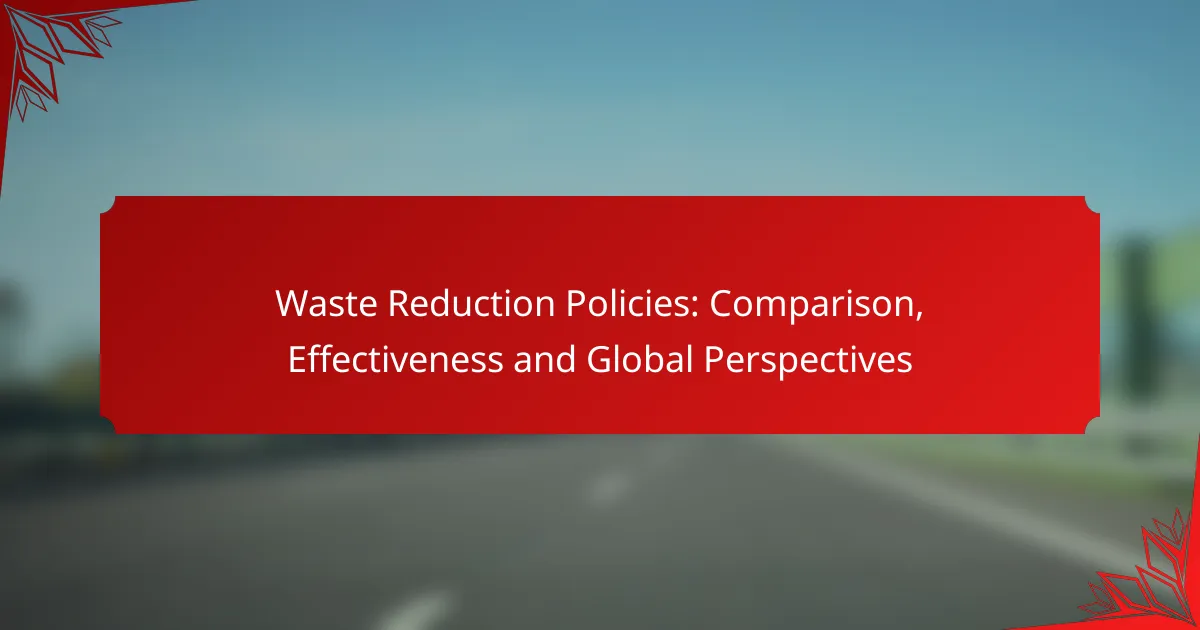Nonprofits play a crucial role in reducing waste in urban areas through targeted initiatives focused on food recovery, recycling, and community engagement. By showcasing successful case studies, these organizations highlight effective strategies that not only minimize waste but also inspire community participation and foster sustainable practices.
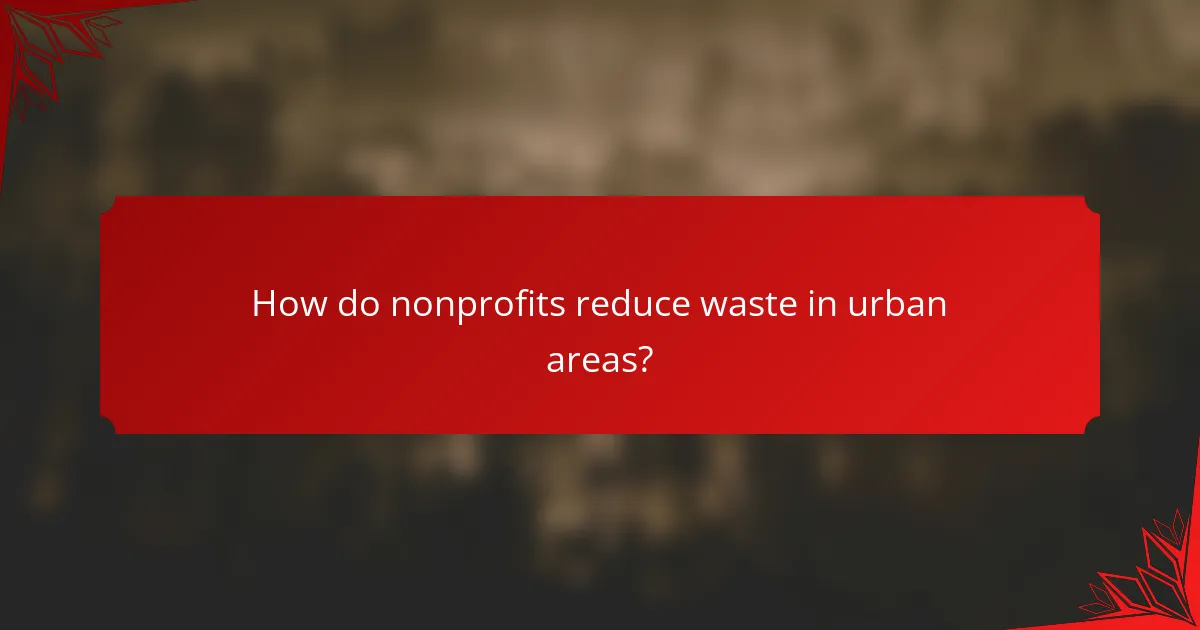
How do nonprofits reduce waste in urban areas?
Nonprofits reduce waste in urban areas through targeted initiatives that focus on food recovery, recycling, and community engagement. By implementing programs that address specific waste streams, these organizations foster sustainable practices and encourage local participation.
Food Rescue Programs
Food rescue programs aim to divert surplus food from landfills by redistributing it to those in need. Nonprofits partner with local grocery stores, restaurants, and farms to collect edible food that would otherwise go to waste.
These initiatives often involve volunteers who pick up and deliver food to shelters and food banks. For example, a typical program might rescue thousands of pounds of food each month, significantly reducing waste while addressing food insecurity.
Recycling Initiatives
Recycling initiatives focus on increasing the diversion of recyclable materials from urban waste streams. Nonprofits often run educational campaigns to inform residents about proper recycling practices and the importance of reducing contamination.
Some organizations facilitate drop-off centers or curbside pickup services for recyclables, making it easier for communities to participate. They may also collaborate with local governments to improve recycling infrastructure and promote compliance with local regulations.
Community Clean-Up Events
Community clean-up events engage residents in hands-on efforts to remove litter and debris from public spaces. These events not only beautify neighborhoods but also raise awareness about waste management and environmental stewardship.
Typically organized by local nonprofits, these clean-ups can attract dozens to hundreds of volunteers. Participants often receive supplies like gloves and trash bags, and some events may even include incentives, such as refreshments or community service hours, to encourage participation.
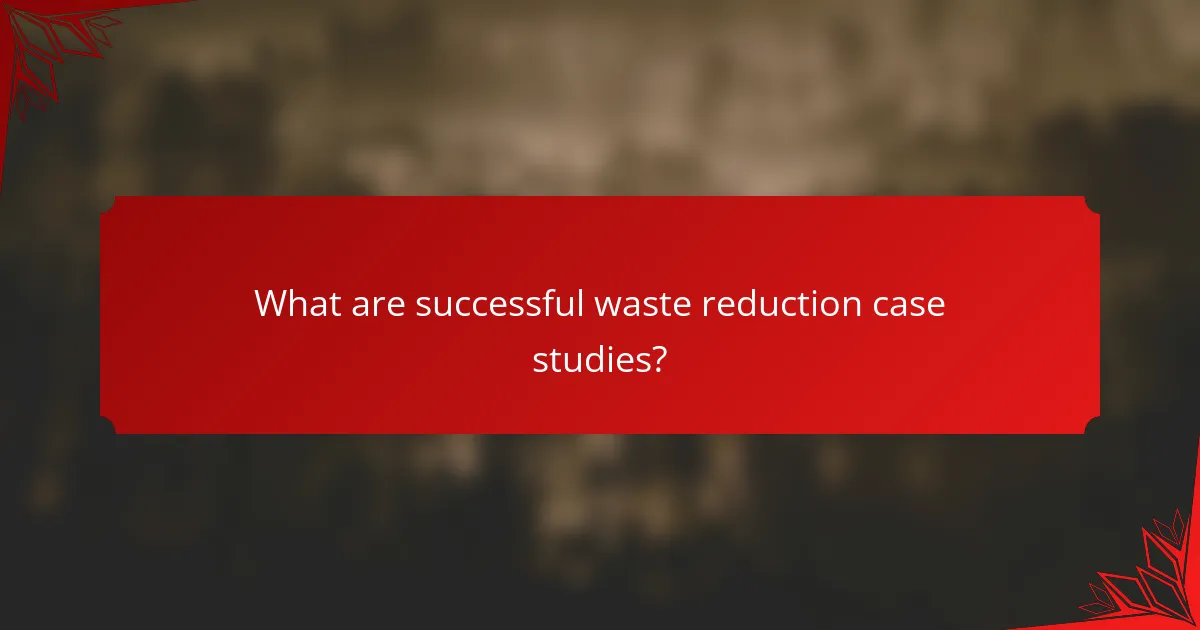
What are successful waste reduction case studies?
Successful waste reduction case studies showcase effective strategies and initiatives that organizations have implemented to minimize waste and promote sustainability. These examples highlight community engagement, innovative practices, and measurable impacts that inspire others to adopt similar approaches.
City Harvest in New York
City Harvest is a nonprofit dedicated to rescuing surplus food and delivering it to those in need across New York City. By partnering with restaurants, grocers, and farms, they collect millions of pounds of food that would otherwise go to waste, providing nutritious meals to vulnerable populations.
The organization emphasizes community involvement, encouraging volunteers to participate in food rescue operations. This not only helps reduce waste but also raises awareness about food insecurity and the importance of sustainable practices.
Green City Force in Brooklyn
Green City Force engages young adults in Brooklyn through green job training and community service, focusing on sustainability and waste reduction. Their programs teach participants about urban agriculture, composting, and energy efficiency, equipping them with skills to contribute to environmental initiatives.
By implementing community composting projects, Green City Force reduces organic waste while fostering a sense of ownership and responsibility among residents. Their efforts demonstrate how empowering local youth can lead to significant waste reduction and community improvement.
Keep America Beautiful
Keep America Beautiful is a national nonprofit that promotes litter prevention, waste reduction, and community beautification. Their programs encourage local communities to take action through clean-up events, educational campaigns, and recycling initiatives.
By fostering partnerships with businesses and local governments, Keep America Beautiful has successfully implemented various waste reduction strategies across the country. Their focus on grassroots engagement empowers communities to create lasting change and reduce waste effectively.
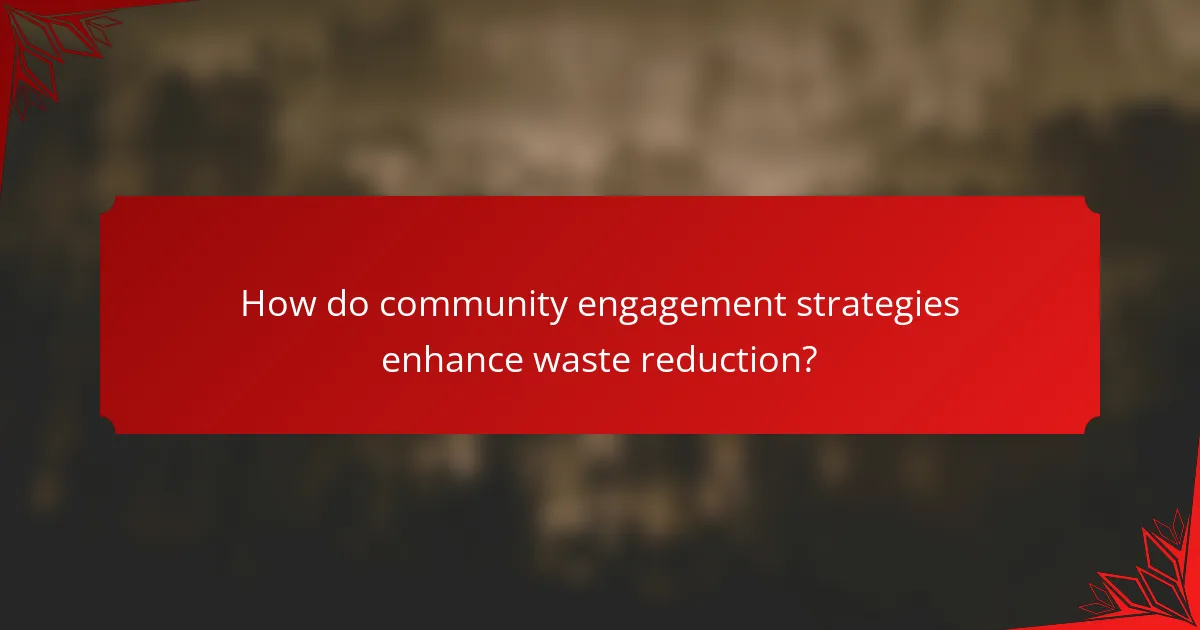
How do community engagement strategies enhance waste reduction?
Community engagement strategies significantly enhance waste reduction by fostering collaboration and raising awareness among residents. These approaches empower individuals to take action, leading to more sustainable practices and a collective commitment to minimizing waste.
Volunteer Programs
Volunteer programs are essential for mobilizing community members to participate in waste reduction initiatives. These programs often involve activities such as neighborhood clean-ups, recycling drives, and composting workshops, which not only reduce waste but also build a sense of community. Engaging volunteers can lead to increased ownership of local environmental issues and inspire others to join the cause.
To implement a successful volunteer program, consider establishing clear goals, providing training, and recognizing volunteer contributions. For example, a local nonprofit might organize monthly clean-up events, encouraging participants to track the amount of waste collected to highlight the program’s impact.
Educational Workshops
Educational workshops play a crucial role in teaching community members about waste reduction techniques and sustainable practices. These workshops can cover topics such as recycling best practices, composting methods, and the importance of reducing single-use plastics. By providing practical knowledge, participants are more likely to adopt environmentally friendly habits.
When organizing workshops, focus on interactive formats that encourage participation. For instance, a workshop could include hands-on activities like building a compost bin or creating DIY cleaning products from natural ingredients. Offering these sessions in local community centers or schools can maximize attendance and engagement.
Social Media Campaigns
Social media campaigns are effective tools for raising awareness and promoting waste reduction initiatives within the community. By leveraging platforms like Facebook, Instagram, and Twitter, organizations can share tips, success stories, and upcoming events, reaching a broader audience. Engaging visuals and compelling narratives can motivate individuals to participate in waste reduction efforts.
To create a successful social media campaign, consider using hashtags related to waste reduction and encouraging followers to share their own experiences. For example, a campaign could challenge community members to reduce their waste for a month and share their progress online. This not only fosters a sense of accountability but also builds a supportive network around waste reduction efforts.
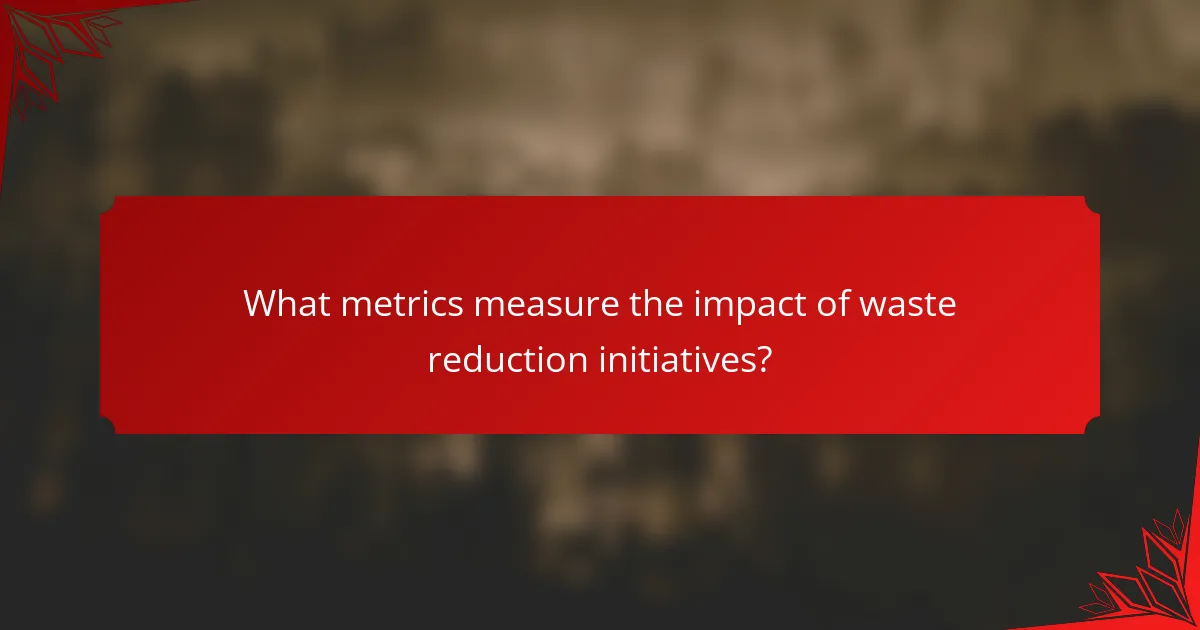
What metrics measure the impact of waste reduction initiatives?
Metrics for measuring the impact of waste reduction initiatives include waste diversion rates, community participation levels, and environmental impact assessments. These metrics provide insights into how effectively a program is reducing waste and engaging the community.
Waste Diversion Rates
Waste diversion rates indicate the percentage of waste materials that are diverted from landfills through recycling, composting, or reuse. A successful initiative typically aims for diversion rates of 30% to 50%, depending on local regulations and available facilities.
To calculate this rate, divide the total amount of waste diverted by the total waste generated, then multiply by 100. For example, if a community diverts 500 tons of waste out of 1,000 tons generated, the diversion rate is 50%.
Community Participation Levels
Community participation levels reflect how engaged residents are in waste reduction efforts. High participation can be measured through the number of households enrolled in recycling programs or the attendance at community clean-up events.
Effective initiatives often see participation rates of 40% to 70% in urban areas. Engaging the community through educational workshops and incentives can significantly boost these levels, fostering a culture of sustainability.
Environmental Impact Assessments
Environmental impact assessments evaluate the broader ecological effects of waste reduction initiatives. These assessments consider factors such as reductions in greenhouse gas emissions, improvements in air and water quality, and the conservation of natural resources.
Conducting these assessments involves collecting data before and after implementing waste reduction strategies. For instance, a program that reduces landfill waste by 1,000 tons may correlate with a measurable decrease in methane emissions, contributing to climate change mitigation efforts.
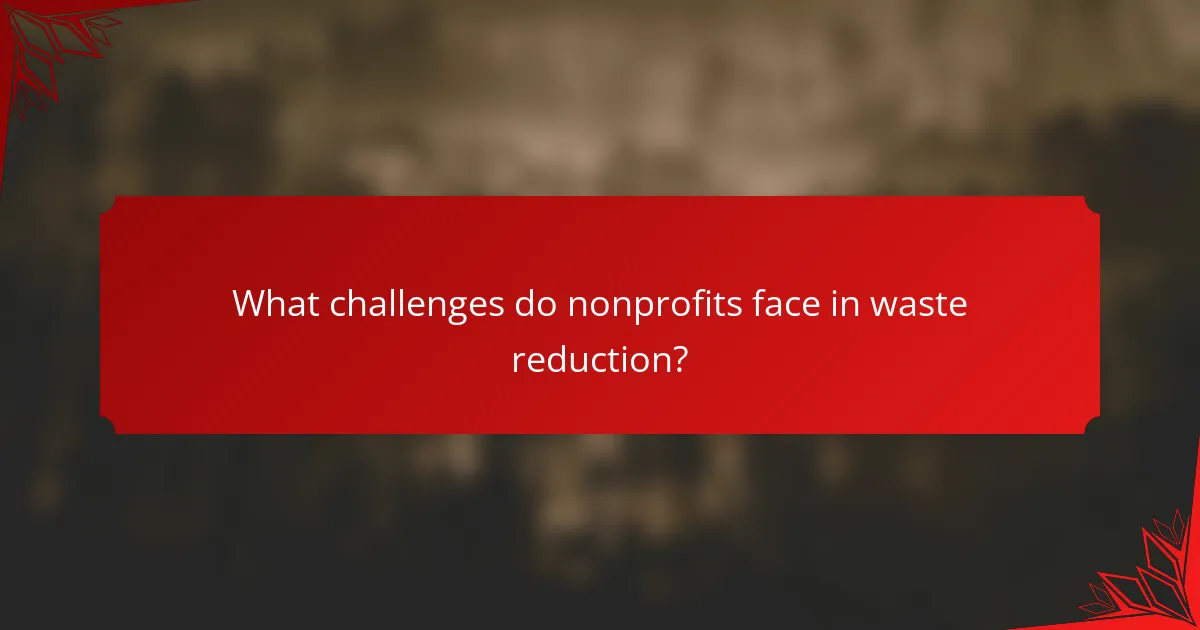
What challenges do nonprofits face in waste reduction?
Nonprofits encounter several challenges in waste reduction, including limited funding, community resistance, and logistical issues. These obstacles can hinder their ability to implement effective waste management strategies and engage the community in sustainable practices.
Funding Limitations
Many nonprofits struggle with funding limitations that restrict their capacity to invest in waste reduction initiatives. Grants and donations may not always cover the costs associated with implementing new programs or technologies aimed at minimizing waste.
To overcome funding challenges, nonprofits can explore partnerships with local businesses or government agencies that may provide financial support or resources. Additionally, applying for grants specifically focused on environmental sustainability can help secure necessary funds.
Community Resistance
Community resistance can significantly impede waste reduction efforts, as local residents may be hesitant to change their habits or adopt new practices. This resistance often stems from a lack of awareness or understanding of the benefits of waste reduction.
Engaging the community through education and outreach programs is essential to address this issue. Nonprofits should focus on demonstrating the positive impact of waste reduction on the environment and local economy, which can help foster community buy-in.
Logistical Issues
Logistical issues, such as inadequate infrastructure for recycling and waste management, pose significant challenges for nonprofits. Limited access to recycling facilities or transportation can hinder the effective collection and processing of waste materials.
To navigate these logistical hurdles, nonprofits should assess local waste management systems and identify potential partnerships with existing services. Collaborating with local governments or waste management companies can enhance operational efficiency and improve waste diversion rates.
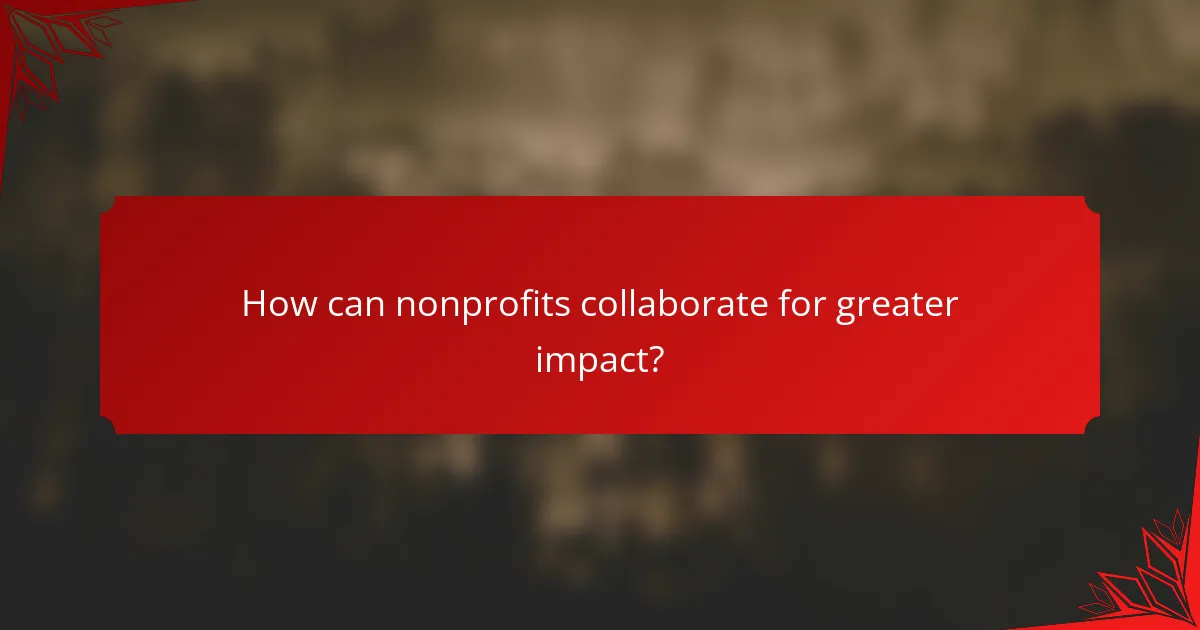
How can nonprofits collaborate for greater impact?
Nonprofits can enhance their impact by forming strategic collaborations that leverage resources, expertise, and community connections. By working together, these organizations can address waste reduction more effectively and create a larger collective footprint.
Partnerships with Local Businesses
Collaborating with local businesses allows nonprofits to tap into additional resources and expertise while promoting sustainable practices. These partnerships can involve co-hosting events, sharing facilities, or developing joint marketing campaigns that highlight waste reduction efforts.
For example, a nonprofit focused on recycling can partner with a local grocery store to set up a recycling drop-off point. This not only increases the store’s community engagement but also provides the nonprofit with a steady stream of materials to process.
When forming partnerships, nonprofits should consider aligning their missions with those of local businesses to ensure mutual benefits. Regular communication and clear expectations are essential to maintain a successful collaboration.

